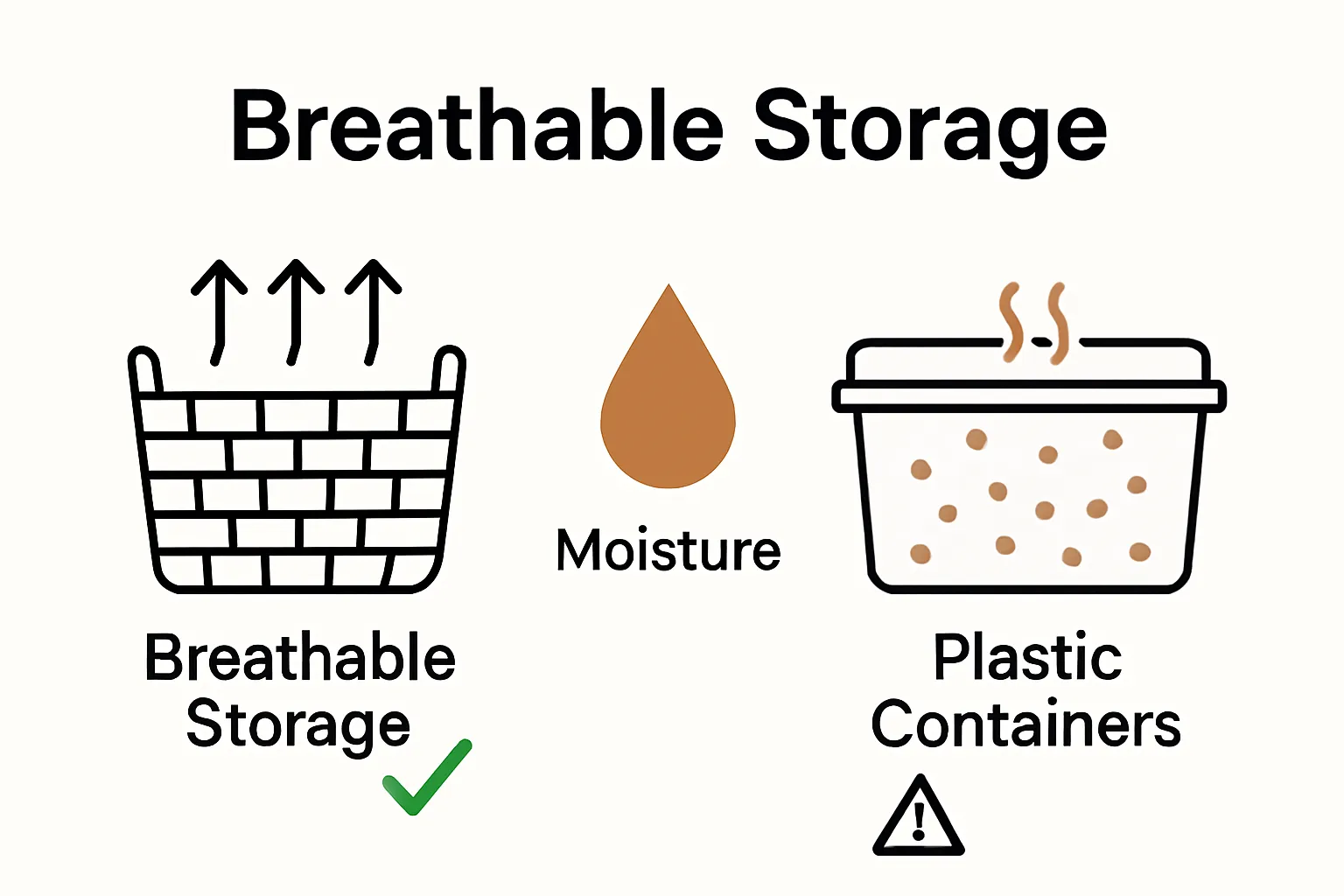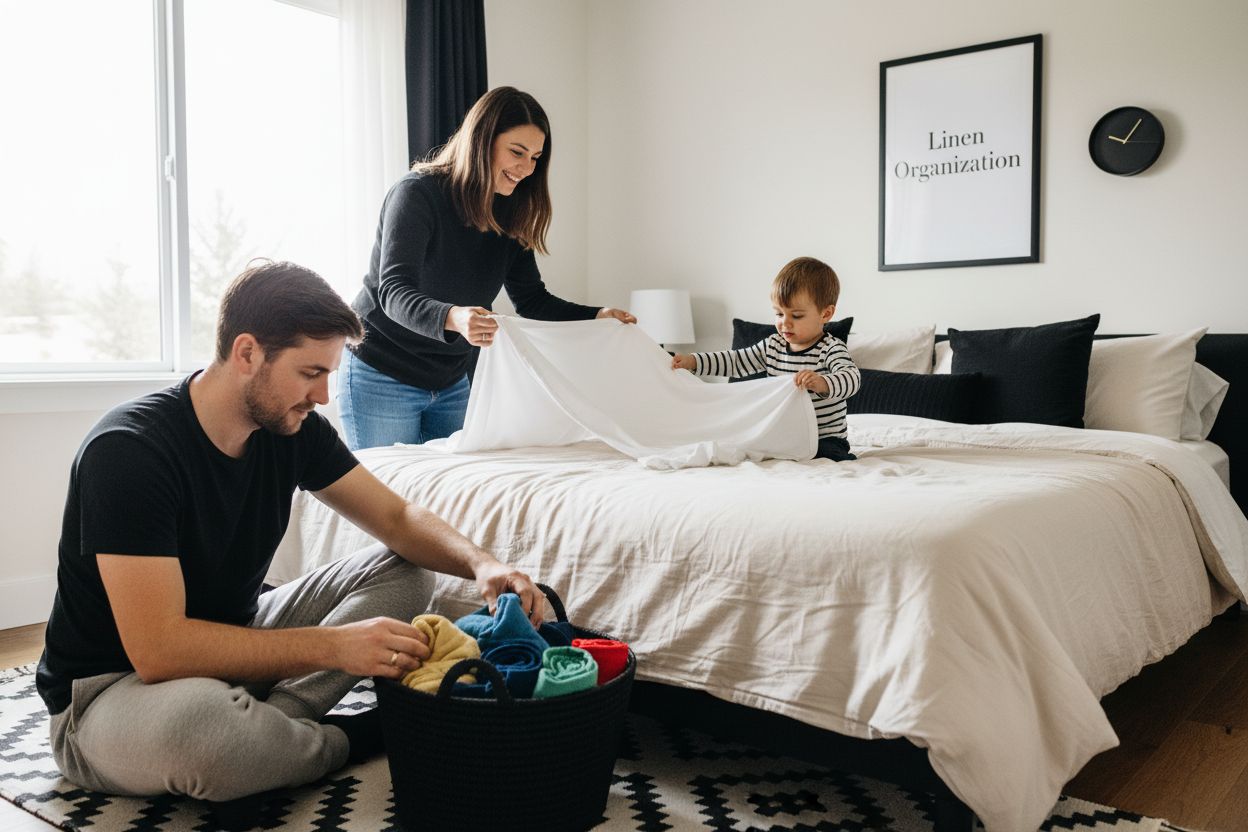
Storing your linens the right way makes a bigger difference than most people realize and studies show that proper storage can double the lifespan of your fabric investments. Most folks figure tossing sheets into a closet is all it takes but they are missing a crucial step. What actually preserves the comfort and freshness you love comes down to clever storage techniques that protect much more than just appearances.
Table of Contents
- The Importance Of Proper Linen Storage
- Factors Affecting Linen Preservation
- Choosing The Right Storage Solutions
- Organizational Strategies For Linen
- Maintaining Linen Quality Over Time
Quick Summary
| Takeaway | Explanation |
|---|---|
| Control humidity for linen preservation | Maintain humidity levels between 45-55% to prevent mold and fabric damage. |
| Use breathable storage containers | Choose containers that allow air circulation to avoid chemical degradation and moisture build-up. |
| Organize linens by type | Group linens into categories for easy access and better preservation strategies. |
| Conduct regular inspections | Regularly check linens for damage to address minor issues before they become serious. |
| Implement gentle cleaning techniques | Use appropriate cleaning methods for different fabrics to maintain their quality and longevity. |
The Importance of Proper Linen Storage
Linen storage goes far beyond simply folding and stacking textiles in a closet. Proper storage practices protect your valuable fabric investments, maintain their quality, and extend their usable lifespan. Understanding the nuanced approach to storing linens can transform how you manage and preserve these essential household textiles.
Protecting Fabric Integrity and Longevity
Quality linens represent a significant investment for many households. Our comprehensive guide on linen care highlights that improper storage can dramatically reduce the lifespan of your textiles. Environmental factors like moisture, temperature fluctuations, and exposure to direct sunlight can cause irreversible damage to fabric fibers.
Textile preservation experts recommend specific storage techniques that minimize wear and tear. According to research from the Textile Conservation Center, proper storage involves:
- Controlling humidity levels to prevent mold and mildew
- Protecting fabrics from direct sunlight to prevent color fading
- Using breathable storage containers that allow air circulation
Preventing Common Storage Challenges
Common storage mistakes can lead to significant fabric degradation. Compressing linens too tightly, storing them in plastic containers, or placing them in areas with high humidity can cause permanent damage. Cotton and linen fabrics are particularly susceptible to environmental stress, requiring careful handling and strategic storage solutions.
By implementing thoughtful storage practices, you can ensure that your linens remain fresh, crisp, and ready for use. The key is understanding the unique characteristics of different fabric types and creating a storage environment that supports their preservation.
Proper linen storage is not just about organization—it is about protecting your home textiles and maintaining their beauty and functionality for years to come.
Factors Affecting Linen Preservation
Linen preservation requires a sophisticated understanding of the environmental and handling factors that can impact textile durability. Protecting your linens involves more than casual storage—it demands strategic environmental management and careful material handling.
Environmental Conditions and Textile Degradation
Explore our advanced storage solutions that help mitigate fabric deterioration. According to conservation research from the Smithsonian Institution, several critical environmental factors directly influence linen quality:
- Relative humidity levels between 45-55% optimize fabric preservation
- Temperature fluctuations accelerate fabric fiber breakdown
- Direct sunlight exposure causes permanent color fading and material weakening
Chemical and Physical Stress Factors
Beyond environmental conditions, chemical interactions and physical handling significantly impact linen longevity. Residual body oils, perspiration, cosmetic products, and cleaning chemical interactions can gradually degrade fabric fibers. Additionally, mechanical stress from improper folding, compressed storage, or frequent rough handling contributes to textile deterioration.
Understanding these intricate factors allows homeowners to develop proactive preservation strategies. Implementing protective measures like acid-free tissue paper, temperature-controlled storage areas, and gentle handling techniques can dramatically extend the useful life of your linens.
Preserving linens is a nuanced process that requires knowledge, attention to detail, and a commitment to creating an optimal storage environment. By recognizing and mitigating potential degradation factors, you can maintain the beauty and functionality of your textile investments for years to come.
Below is a comparison table summarizing how key environmental and handling factors affect linen preservation, helping you easily identify their impacts and preventive strategies.
| Factor | Impact on Linen Preservation | Preventive Strategy |
|---|---|---|
| Humidity (Above 55%) | Promotes mold, mildew, and fiber degradation | Maintain 45-55% humidity, use dehumidifiers |
| Temperature Fluctuations | Breaks down fabric structure | Use temperature-controlled storage |
| Direct Sunlight | Causes color fading and fabric weakening | Store linens away from windows and direct light |
| Residual Oils/Chemicals | Gradually weaken and stain fabric fibers | Clean linens before storage, use gentle detergents |
| Mechanical Stress | Leads to permanent creasing and fabric wear | Proper folding, avoid over-compression |
| Plastic Containers (Non-breathable) | Traps moisture leading to mold and fiber breakdown | Use breathable, acid-free storage containers |
| Improper Handling | Accelerates tears and loss of fabric integrity | Handle gently, avoid rough treatment |
Choosing the Right Storage Solutions
Selecting appropriate storage solutions for linens requires a strategic approach that balances preservation needs, space constraints, and aesthetic considerations. The right storage method can significantly enhance textile longevity while maintaining your home’s organizational efficiency.
Material and Design Considerations
Discover our innovative vertical storage options that maximize space and protect your linens. When evaluating storage solutions, textile preservation experts recommend focusing on specific material characteristics:
- Breathable containers that allow air circulation
- Acid-free materials that prevent chemical degradation
- Containers with stable structural integrity
According to research from textile conservation experts, natural materials like cotton and cedar provide superior protection compared to synthetic storage options. Cedar, in particular, offers natural moth repellent properties and helps regulate moisture levels.

Climate and Location Specific Storage
Storage solutions must adapt to specific environmental conditions. Linen storage in humid coastal regions differs dramatically from storage in dry mountain climates. Factors like temperature fluctuations, potential exposure to sunlight, and ambient humidity levels dramatically influence storage strategy.
Wooden cabinets with adjustable shelving, breathable fabric storage bags, and temperature-controlled storage units represent sophisticated solutions for maintaining textile quality. Professional organizers emphasize the importance of selecting storage containers that provide consistent protection while allowing fabric fibers to breathe.
This feature table outlines different storage material options for linens, summarizing their key characteristics and preservation benefits to simplify your selection process.
| Storage Material | Breathability | Chemical Safety | Pest Resistance | Preservation Benefit |
|---|---|---|---|---|
| Cotton | Yes | Acid-free | No | Allows airflow, preserves fiber |
| Cedar | Yes | Acid-free | Yes | Repels moths, controls moisture |
| Synthetic Plastic | No | Can emit chemicals | No | Can cause moisture buildup |
| Acid-free Cardboard | Yes | Acid-free | No | Prevents chemical degradation |
| Polyester Fabric | Limited | May off-gas | No | Less ideal for long-term storage |
Ultimately, choosing the right storage solution is about understanding your specific environmental context, fabric types, and preservation goals. By investing in thoughtful, carefully selected storage methods, you protect not just your linens, but the memories and comfort they represent.
Organizational Strategies for Linen
Effective linen organization transcends simple stacking and sorting—it involves creating a systematic approach that maximizes space, preserves fabric quality, and simplifies household management. Professional organizers understand that strategic categorization and storage techniques can transform how households manage their textile collections.
Categorization and Inventory Management
Learn more about our smart storage organization solutions that streamline textile management. According to professional home organization experts, effective linen organization involves:
- Grouping linens by type (bedroom, bathroom, kitchen)
- Creating designated storage zones for different fabric weights
- Maintaining a digital or physical inventory of textile collections
Research from professional organizing associations suggests that households benefit significantly from implementing structured organizational systems that reduce clutter and improve accessibility.
Strategic Folding and Placement Techniques
Professional organizers emphasize the importance of strategic folding techniques that minimize fabric stress while optimizing storage space. Different textile types require unique folding approaches to prevent permanent creasing and maintain structural integrity. Bulky items like comforters and quilts demand different storage strategies compared to delicate items such as embroidered tablecloths or fine cotton sheets.
Vertical storage solutions, modular shelving systems, and dedicated linen closets provide flexible options for maintaining an organized textile collection. By implementing thoughtful placement strategies, homeowners can create storage environments that protect fabrics while making items easily accessible.
Ultimately, successful linen organization is about creating a personalized system that reflects your household’s unique needs, aesthetic preferences, and practical requirements. A well-designed organizational approach transforms textile storage from a mundane task into an efficient, streamlined process.

Maintaining Linen Quality Over Time
Preserving the quality of linens requires a proactive, comprehensive approach that goes beyond occasional cleaning and sporadic maintenance. Textile preservation involves understanding the intricate relationships between fabric care, storage conditions, and long-term durability.
Regular Inspection and Preventive Care
Explore our shelf organization strategies for maintaining textile integrity. According to conservation experts at the Smithsonian Institution, maintaining linen quality involves:
- Conducting quarterly visual inspections for potential damage
- Identifying and addressing minor wear before it becomes significant
- Rotating linens to ensure even usage and prevent localized deterioration
Professional textile conservators emphasize that consistent, gentle handling and strategic cleaning techniques are fundamental to preserving fabric longevity. Minor interventions performed regularly can prevent substantial degradation over time.
Cleaning and Restoration Techniques
Cleaning linens requires a nuanced approach that balances thorough sanitization with fabric preservation. Different textile compositions demand specialized cleaning methods—delicate embroidered pieces require vastly different treatment compared to robust cotton towels. Professional textile restorers recommend understanding each fabric’s specific care requirements, including appropriate water temperatures, detergent selections, and drying techniques.
Utilizing acid-free tissue paper during storage, implementing gentle washing cycles, and avoiding harsh chemical treatments can significantly extend the lifespan of your linens. By treating textiles as valuable investments rather than disposable commodities, homeowners can maintain their aesthetic and functional quality for generations.
Maintaining linen quality is an ongoing commitment that rewards careful attention with enduring comfort, beauty, and utility. A thoughtful, consistent approach transforms textile care from a routine chore into a meaningful preservation practice.
Transform Your Linen Storage With Effortless Style and Lasting Protection
Tired of linens losing their freshness or getting damaged because of cramped, outdated storage habits? Your linens deserve better care to maintain their beauty and function, and Bedroom Storage offers the ideal solution. Our expertly designed storage products solve the challenges highlighted in the article, including breathable fabric care, protection from humidity, and optimized organization for every kind of textile.

Now is the perfect time to give your linens a better home. Visit https://blushbees.us and explore our range of storage boxes, dividers, and containers built to keep your textiles fresh and organized. Enhance your routine, extend the life of your linens, and enjoy more order in every room. Ready to upgrade your storage game? See our full collection in Bedroom Storage and discover lasting solutions today.
Frequently Asked Questions
What are the best practices for storing linens?
Proper linen storage practices include controlling humidity levels, protecting fabrics from direct sunlight, and using breathable storage containers that allow air circulation.
How can I prevent mold and mildew in my linen storage?
To prevent mold and mildew, maintain relative humidity levels between 45-55%, ensure proper airflow, and store linens in a cool, dry place away from direct sunlight.
What materials should I use for linen storage containers?
Breathable containers made from natural materials like cotton or cedar are ideal for linen storage. Acid-free materials are also recommended to prevent chemical degradation.
How often should I inspect my stored linens?
It’s recommended to conduct quarterly visual inspections of your stored linens to identify and address any minor wear or damage before it becomes significant.



